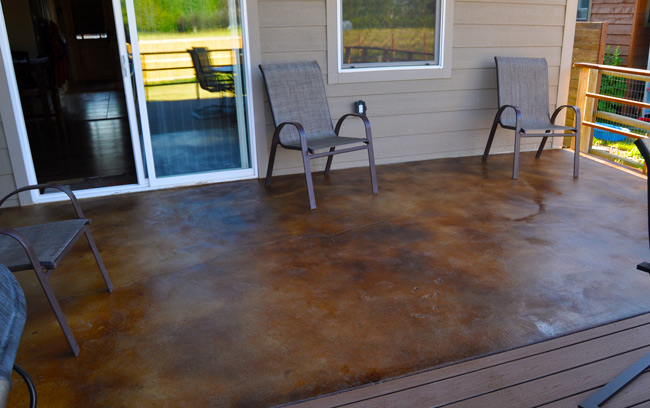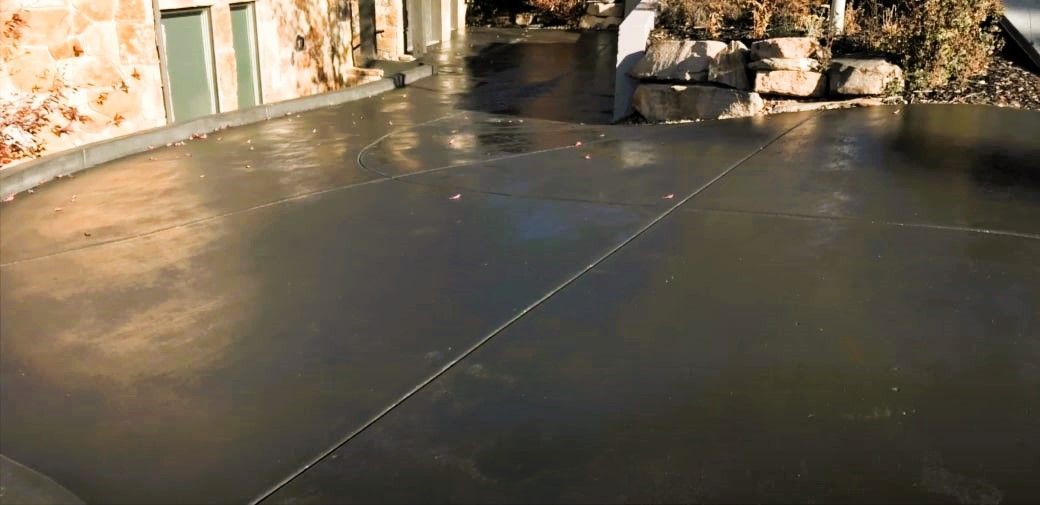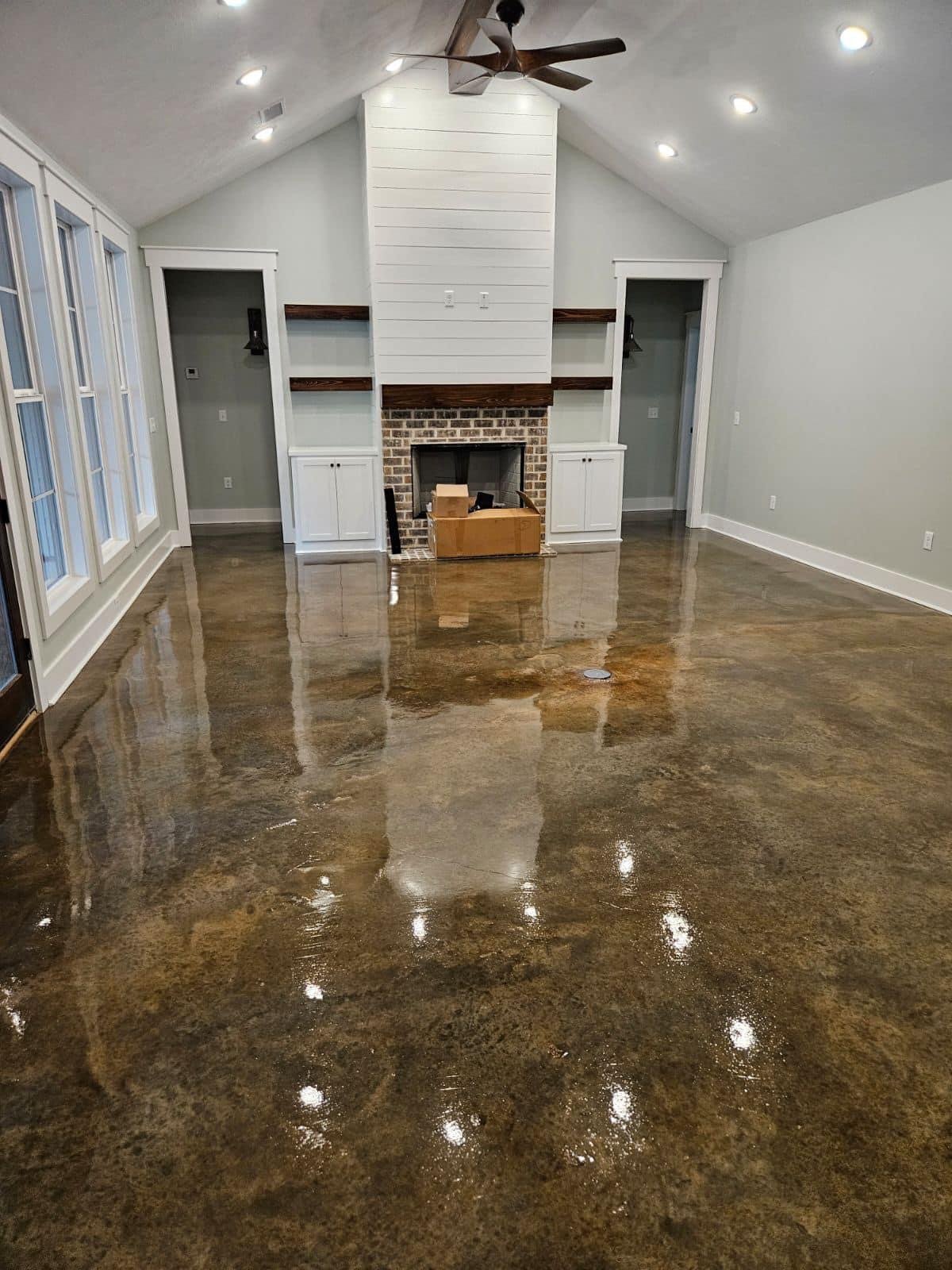How to find a trusted stained concrete company for your home renovation
All Concerning Stained Concrete: A Comprehensive Overview to Its Advantages and Applications
Stained concrete has actually become a popular choice for both residential and industrial areas. Its capability to incorporate aesthetic appeal with functionality makes it an interesting option. Different staining methods offer a variety of colors and coatings, permitting for modification. The advantages extend past look. Comprehending its applications and maintenance needs is essential for any individual considering this versatile material. The subtleties of stained concrete welcome better expedition.
What Is Stained Concrete?

Discoloration can be put on numerous surface areas, consisting of floorings, driveways, and outdoor patios, making it a flexible choice for both indoor and exterior spaces. The therapy can achieve an array of appearances, from earthy tones to bold, modern-day designs. Unlike paint, stained concrete preserves its look with time, as it becomes an indispensable component of the concrete itself. In general, stained concrete functions as an efficient technique for transforming normal concrete right into visually striking surfaces.
Benefits of Stained Concrete
Stained concrete deals substantial advantages, specifically in aesthetic appeal and toughness - local stained concrete. Its dynamic shades and one-of-a-kind patterns improve the aesthetic appeal of any kind of room, making it a preferred option for both household and business applications. Furthermore, the long life of stained concrete guarantees that it continues to be a functional investment gradually, withstanding damage
Aesthetic Appeal
One of one of the most compelling advantages of using stained concrete is its amazing aesthetic allure. Stained concrete deals a special and functional look that can complement numerous layout styles, from modern-day to rustic. The infusion of vibrant colors and complex patterns allows house owners and designers to create personalized surfaces that can enhance the overall setting of a space. Unlike conventional floor covering options, stained concrete can resemble the appearance of all-natural rock or refined marble, supplying a high end look without the connected costs. Additionally, the shiny finish choices can mirror light, further brightening interiors. This adaptability makes stained concrete a favored selection for both household and commercial applications, where visual influence is extremely important.
Resilience and Longevity
The remarkable visual qualities of stained concrete are matched by its remarkable sturdiness and longevity - stained concrete company. Stained concrete surfaces are resistant to wear and tear, making them ideal for high-traffic locations both indoors and outdoors. Their robust nature implies they can endure extreme weather, consisting of severe temperature levels, rainfall, and UV direct exposure, without substantial destruction. On top of that, stained concrete needs very little maintenance compared to other floor covering alternatives, as it does not require constant securing or redecorating. This durability not only decreases replacement costs yet additionally adds to a sustainable building method. In general, stained concrete offers an enduring solution that combines visual appeal with practical benefits, ensuring its value over time
Various Types of Staining Methods
Various staining strategies can significantly affect the aesthetic top qualities of concrete surface areas. The 3 main methods consist of acid staining, which responds chemically with the concrete, water-based discoloration, which offers a wider variety of shades, and overlay discoloration options that give a fresh surface area. Each technique has one-of-a-kind features and applications that deal with numerous design choices and project needs.
Acid Staining Approach
Exactly how can homeowners transform plain concrete surfaces right into visually striking attributes? One effective technique is acid staining, a preferred technique that improves the natural appeal of concrete. This process includes using an option of water, hydrochloric acid, and metallic salts to the concrete surface. As the acid responds with the lime present in the concrete, it develops rich, variegated shades that resemble marble or stone. Acid discoloration is known for its longevity and resistance to fading, making it a durable choice for both interior and outdoor applications. It is important to keep in mind that the results can differ based on the original concrete shade and appearance. Proper application and sealing are crucial for attaining the desired aesthetic and durability
Water-Based Discoloration Strategy
A preferred alternative to acid staining, the water-based staining method uses home owners a versatile way to improve concrete surface areas. This approach makes use of water-soluble dyes and pigments, allowing for a large range of shades and coatings. Unlike acid stains, water-based stains can be put on unsealed concrete and offer a simpler clean-up process. The results can accomplish a much more uniform appearance and can be layered to create distinct impacts. Furthermore, water-based spots are normally much less hazardous and discharge less unpredictable natural substances (VOCs), making them a lot more ecologically friendly. Property owners may value the capacity to tailor their concrete surface areas with different shades, enabling creative expression while maintaining sturdiness and longevity in their floor covering selections.
Overlay Discoloration Options
Many overlay staining choices exist for homeowners aiming to revitalize their concrete surface areas. One popular selection is acid staining, which responds chemically with the concrete to generate abundant, variegated colors. One more alternative is water-based discoloration, using a broader shade palette and easier application. In addition, concrete overlays can be combined with stencils for detailed designs, improving aesthetic appeals. For an extra textured surface, home owners may think about making use of stamped overlays that mimic natural products like stone or tile. Each method gives distinct benefits, from longevity to personalization, enabling a personalized touch. Eventually, the option of overlay discoloration relies on the wanted look and the condition of the existing concrete, guaranteeing a freshened and enticing surface area.
Applications of Stained Concrete
Stained concrete deals a versatile service for different applications, improving both aesthetic charm and performance. This product is generally made use of in household, commercial, and industrial setups, making it a popular choice among engineers and designers. In homes, stained concrete can function as stylish flooring or outdoor patios, providing a sophisticated appearance while continuing to be additional resources sturdy.
In business rooms, such as retail shops and dining establishments, stained concrete adds to a contemporary atmosphere and can endure heavy foot web traffic. Furthermore, stained concrete is increasingly used in public areas like parks and sidewalks, where its capability to simulate natural rock or other products adds visual passion.
In addition, stained concrete is excellent for swimming pool decks and driveways, using a slip-resistant surface that is easy to maintain. In general, the adaptability of stained concrete makes it suitable for countless atmospheres, accommodating varied tastes and requirements.
Upkeep and Look After Stained Concrete
Correct upkeep ensures the long life and appeal of stained concrete surface areas. Normal cleansing see here is necessary; using a light detergent and water with a soft-bristle brush aids get rid of dust and gunk without damaging the surface. It is advisable to prevent harsh chemicals that can remove the stain or sealant.
Securing stained concrete is vital for security versus moisture, spots, and put on. A top notch sealant ought to be reapplied each to 3 years, depending on the web traffic and direct exposure the surface withstands. In addition, dealing with spills immediately will prevent staining and discoloration.

Expense Considerations for Stained Concrete Projects
When preparing a stained concrete job, budget considerations play an essential function in determining the general price. The costs connected with stained concrete can vary substantially based on a number of factors. Initially, the dimension of the area to be stained directly affects product and labor expenses. Bigger rooms will naturally need even more resources. Second, the sort of tarnish picked-- acid-based or water-based-- can affect prices, with acid discolorations frequently being extra expensive. Furthermore, the intricacy of the layout, consisting of patterns or multiple colors, can boost labor prices. Preparation work, such as cleaning and grinding the concrete surface, adds to the preliminary costs. The selection in between Do it yourself installment and working with a professional contractor will further impact the budget. Understanding these elements enables property owners to make educated monetary decisions about their stained concrete projects, ensuring they attain the wanted visual within their economic ways.
Tips for Selecting the Right Stained Concrete for Your Area
Choosing the right stained concrete for a particular space entails mindful consideration of different elements beyond just budget. One ought to evaluate the desired usage of the area. High-traffic areas might need more sturdy finishes, while decorative applications can focus on aesthetics.
The shade combination is one more vital facet; the selected hues need to balance with existing design and lights. It's likewise essential to consider the surface area texture, as smooth coatings can improve sophistication, while distinctive options might guarantee safety and security in wet locations.
Regional environment and environmental problems play a considerable role in the longevity and maintenance of stained concrete, affecting the choice of sealants and finishes.
Lastly, seeking advice from experts can click over here now provide useful insights tailored to details demands, assuring the selection of the excellent stained concrete that lines up with both capability and style.

Often Asked Concerns
Can Stained Concrete Be Applied Over Existing Flooring?
Stained concrete can certainly be used over existing floor covering, provided the surface area is secure and effectively prepared. This technique enables a visual upgrade without the requirement for complete elimination of the original floor covering materials.
How Much Time Does Stained Concrete Last?
Stained concrete can last for decades when effectively preserved. Elements such as website traffic, environmental problems, and application methods significantly affect its durability, with several setups remaining lively and intact for 10 to thirty years.
Is Stained Concrete Slippery When Wet?
Stained concrete can be unsafe when damp, as the surface might create a smooth surface area. Using non-slip additives or distinctive finishes can alleviate this issue, improving safety and security without compromising the aesthetic allure of the concrete.
Can I Stain Concrete Myself, or Should I Employ a Specialist?
The decision to stain concrete directly or work with a professional rest on ability degree and task complexity. While DIY discoloration can conserve cash, professionals ensure excellent results, particularly for complex layouts or huge surfaces.
What Colors Are Offered for Stained Concrete?
The range of shades readily available for stained concrete consists of earthy tones like browns and tans, dynamic tones such as reds and blues, and softer colors like pastels. This scheme permits creative, individualized layout alternatives.